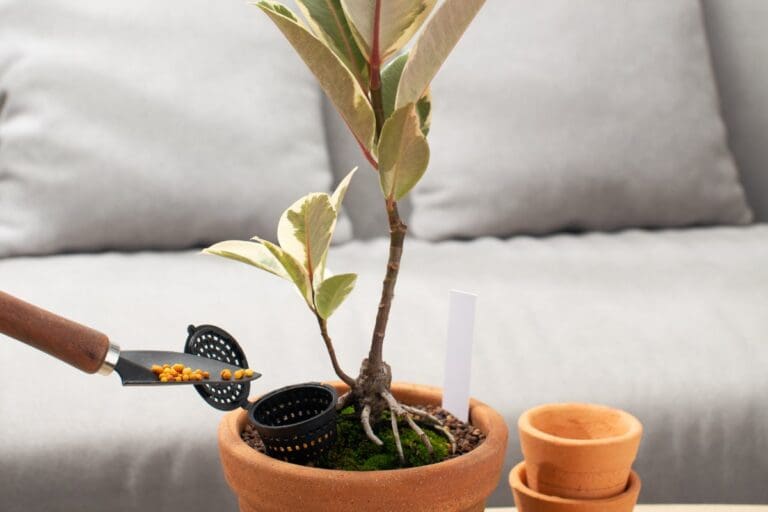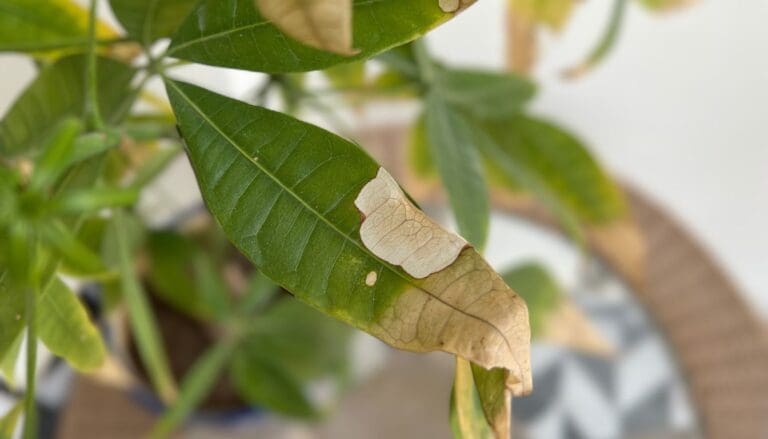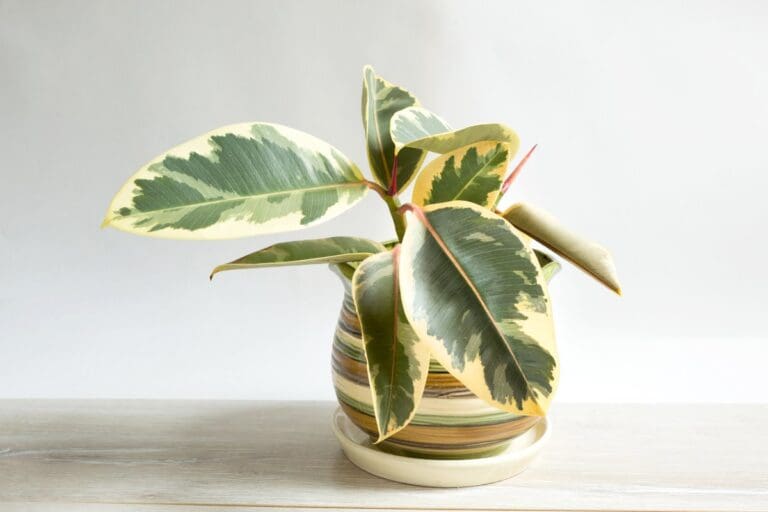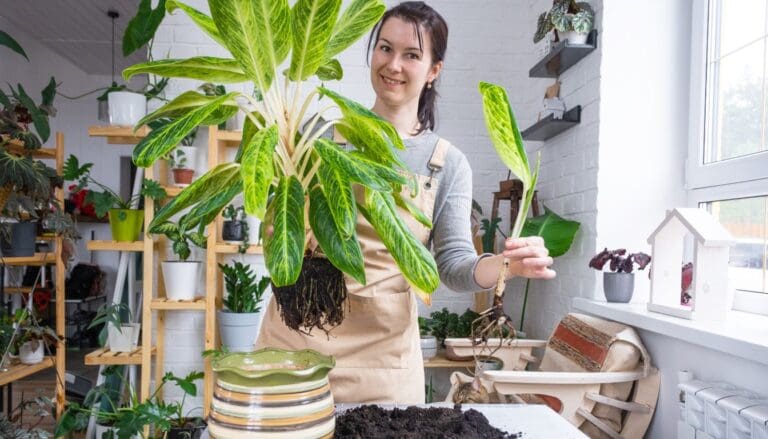Does English Ivy Like To Be Root Bound? (When+How To Fix)
English ivies (Hedera Helix) are evergreen plants known for their trailing vines and low-maintenance nature. This popular plant is ideal for both indoor and outdoor settings. If you are an English ivy owner, you might ask if it enjoys being root-bound.
English ivy prefers being slightly root bound but keeping it root bound for a long period can cause problems like the roots outgrowing the pot, discolored leaves, and stunted growth. To fix this problem, repot the ivy whenever it shows signs of being extremely root-bound.
In this article, we will learn about the rootbound condition in English ivy and how we can fix the plant if it becomes an issue.

Please note: Simplify Plants is reader-supported. Some links in the post are affiliate links and I get a commission from purchases made through links in the post.
Does English ivy like to be potbound?
English ivy has a shallow root system, so it enjoys being slightly root bound.
In nature, ivies grow compact, and keeping them rootbound will give them a feel of their native region.
A small pot will provide the plant with some temporary benefits.
In a small pot, the plant’s roots will stay quite close, causing them to be root bound.
Keeping ivy in a small pot will help it generate new growth, prevent root rot problems, and not let the soil remain soggy.
Also, in a small pot, the roots can easily fetch water and nutrients from the soil compared to a larger pot.
However, growing the Ivy in a small pot for a prolonged period can cause problems.
When the roots don’t get enough space, it harms the plant’s health.
There is a decline in the plant’s growth rate, lesser nutrients remain in the soil, and soil starts drying up.
Whenever you notice such signs, repot your ivy immediately to a new pot.
How will I understand if my English ivy is root bound?
If you think that your ivy has any root-bound issues, you can check the following signs:
Dry plant
An extremely rootbound English ivy will show the sign of dehydration.
The leaves will turn dry and curly and will gradually lose their color.
And in such conditions, watering will also not help the plant to recover.
It is because the ivy grows many roots, which take up all the moisture or are not getting any due to their damaged condition.
Weaker stems and roots
Another sign of a rootbound English ivy is weaker roots and stems.
The plant can become weak even if you provide it with sufficient nutrients.
The roots break down all the nutrients in the soil and supply them to different parts of the plant.
If the roots outgrow the pot, it will fail to absorb the essential nutrients from the soil that the plant needs.
As a result, the plant will become weak due to nutrient deficiency.
Roots outgrow the pot.
The English ivy is rootbound if the roots have outgrown their pot.
If you notice that some plant roots are coming out from the drainage holes in the pot, it’s a sign of a root-bound condition.
Roots coming to the soil surface
Another important sign of a root-bound ivy is when the roots start pushing out of the topsoil.
The roots, in search of more space, will push themselves up to the top layer of the soil and might come out by breaking the soil.
A cracked pot
The pot in which you grow your ivy can also indicate a rootbound situation.
If you haven’t repotted your ivy for many years, the roots will tighten and form a ball-like structure inside the soil.
The pressure from the roots will cause cracks in the clay pots.
Different stages of a rootbound English ivy

A rootbound English ivy will show you three different stages.
It’s somehow easy to recover the plant in the first stage, but it becomes probably difficult when the plant reaches the last stage.
Let us now understand all of the stages in detail.
| First stage | Second stage | Third stage |
|---|---|---|
| In the first stage, the English ivy’s roots start getting tangled. You can easily save the plant in the first stage by detangling the roots from each other. Once you detangle the roots, shift the plant to a larger pot to avoid this problem in the future. | In the second stage, the roots become strong and grow aggressively, searching for more space. They form a cluster-like structure known as the root ball. In this stage, they start to come out from the drainage holes. You must act fast by repotting the plant in a new pot to save it from further damage. | In the third stage, saving the rootbound ivy becomes difficult. The roots form clusters and stick to the pot. In this stage, the ivy stops growing, and the roots suffocate due to a lack of air and space. In such a case, you need to shift your plant to a larger pot and provide it with proper care. |
When should I repot my English ivy?
The growth of an English ivy depends on the species and the climatic conditions.
The plant will show maximum growth during the spring and summer as it is their active season.
If your ivy has stopped growing during its growing season or the roots start coming out through the pot’s surface, it indicates a severe rootbound state.
Below I have mentioned some cases that might signal that you repot your English ivy.
- The water starts to flow from the pot as soon you water the ivy.
- Roots come out of the soil surface and the drainage holes.
- The plant becomes dry since the roots can’t absorb the water from the soil anymore.
- The roots get tangled with each other.
- The roots circle the soil mass and can be seen all over the pot.
- Cracks on the clay pot due to root pressure.
How to select the best pot for English ivy?
The growth of your English Ivy is highly affected by the type of pot you are using for growing it.
Hence, it is important to select the correct pot.
Otherwise, your plant will face many problems.
The selection of a pot for your ivy depends on some factors:
- Size of the plant
- Drainage holes in the pot
- Material of the pot
While repotting, you should always select a pot that is 1-2 inches larger than the previous pot.
A correct-sized pot will maintain the proper balance between the root and soil ratios.
You should keep changing the pot according to the size of your plant.
Ensure the pot has enough drainage holes for draining the excess water from the soil.
Also, the material of the pot should allow proper airflow for the roots to breathe properly.
You can choose terracotta, clay, wooden, or ceramic pot for growing your English ivy.
These pots are made of breathable material and allow good airflow through their surface.
How to save a root-bound English ivy?

If your English ivy has been rootbound, you must take the necessary steps to fix it.
English ivy can bear rootbound conditions for a certain period, but it won’t be able to survive for long if you don’t repot it.
Repot the plant as soon as you notice the roots outgrowing the pot.
Let us look at the steps involved in saving your rootbound English ivy.
1. Inspect the plant
At first, you should carefully inspect the condition of your English ivy, the pot, and the soil.
Try to determine the stage of the rootbound condition of the plant.
A rootbound English ivy’s roots can come from any possible space in the pot.
Check the bottom of the pot to find the tips of any roots.
If you notice the outgrown roots, you must not wait and repot the plant immediately.
2. Remove the root-bound English ivy
In this step, carefully remove your English ivy from its pot.
You can water the plant before taking it out so the soil loosens up and it becomes easier to pull the plant.
It might become difficult to pull the plant at once since the roots get attached to the pot.
You can start by gently squeezing the pot with your hand.
Hold the pot from the base and pull out the plant by holding its stem.
Before you detangle the roots, place the plant in a water bowl to separate the soil from the roots.
Once the roots are clean, take a fork and start detangling them.
3. Prune off the roots and the leggy growth
If you notice brown, mushy, or damaged roots, prune them with a pair of sharp pruners.
Disinfect the pruners by wiping them with a household disinfectant before trimming the roots.
Wash the healthy roots with a fungicide solution before repotting them.
Cut back all the extra roots from your ivy and trim off the leggy foliage, damaged and discolored leaves, if any.
4 Arrange a potting mix and a new pot
The potting mix for English ivy should be well aerated, well-drained, and nutrient-rich.
Prepare an ideal potting mix by mixing peat moss, perlite, and potting soil in a ratio of 1:1:1.
If you don’t want to use a new potting soil, you can use the old potting mix after disinfecting it.
Choose a pot that is 1 inch bigger in diameter than the previous pot.
Do not select a very large pot.
Otherwise, the plant will remain consistently wet and get root rot issues.
5. Repot the English ivy
To repot an English ivy plant, Fill 1/3 of the pot with the potting mix.
Spread the roots and place your English ivy carefully in the new pot.
The top of the root ball should be an inch below the pot’s rim.
Fill the rest of the pot with potting mix and tap the pot from all sides so that the plant can settle in the new pot.
Once you are done with repotting, water the ivy thoroughly until the moisture starts seeping out from the pot’s bottom.
Final words
English ivy has a shallow root system, so they like to stay rootbound. However, the plant faces the negative impacts of a severe rootbound condition if it hasn’t been repotted over the years.
If your English Ivy shows signs of distress, you check the roots by pulling them out. If you find a severe rootbound condition, transplant the plant to a new pot as soon as possible.
The best time to repot an English Ivy is during the springtime. Repotting the plant during the active growing season will help it easily recover from stress. Never repot Your Ivy during winters as it is the dormant season and doesn’t focus on growth.
You should repot your English Ivy plant every 1 to 3 to ensure healthy growth. Never ignore your plant when it shows signs of the rootbound condition and try to fix it as quickly as possible.
Reference: Researchgate, University of Tennessee, Mississippi State University, Central Florida Research and Education Center, U.S. DEPARTMENT OF AGRICULTURE.
Recommended Garden Supplies
| Product Image | Our Recommended Gardening Supplies | Check Offers! |
|---|---|---|
Top Top
Top
Top
Top
Top
Top
Top
Top | rePotme Houseplant and Tropical Classic Potting Soil Mix | Check Offer On Amazon |
 Top
Top
Top
Top
Top
Top
Top
Top | Espoma Organic Indoor Plant Food | Check Offer On Amazon |
 Top
Top
Top
Top
Top
Top
Top
Top | GooingTop LED Grow Light 6000K Full Spectrum Clip Plant Growing Lamp | Check Offer On Amazon |
 Top
Top
Top
Top
Top
Top
Top
Top | Soil Moisture Meter | Check Offer On Amazon |
 Top
Top
Top
Top
Top
Top
Top
Top | Govee Hygrometer Thermometer, Bluetooth Enabled! | Check Offer On Amazon |
 Top
Top | LEVOIT Humidifiers for Large Room(Best For Plants) | Check Offer On Amazon |
 Top
Top
Top
Top
Top
Top
Top
Top | Upgraded DIY Automatic Drip Irrigation Kit, 15 Potted Houseplants Support | Check Offer On Amazon |
 Top
Top
Top
Top
Top
Top
Top
Top | Stainless Steel Heavy Duty Gardening Tool Set | Check Offer On Amazon |
 Top
Top
Top
Top
Top
Top
Top
Top | Bonide Insecticidal Soap | Check Offer On Amazon |
 Top
Top
Top
Top
Top
Top
Top
Top | Bonide 32 oz Spray Neem Oil for Organic Gardening | Check Offer On Amazon |
 Top
Top
Top
Top
Top
Top
Top
Top | Garden Safe Fungicide | Check Offer On Amazon |






